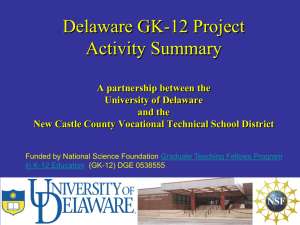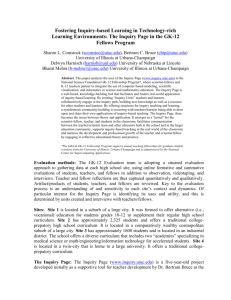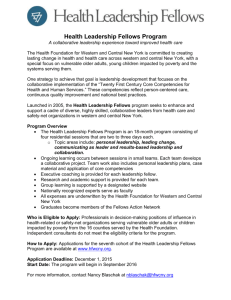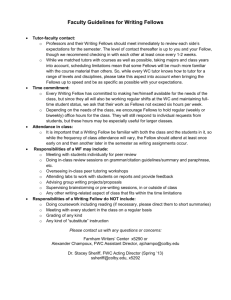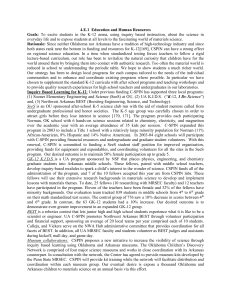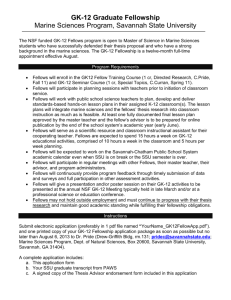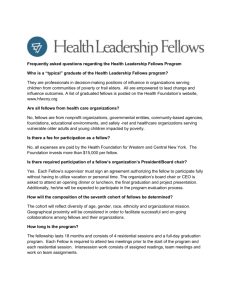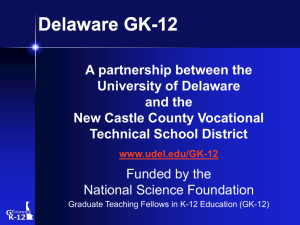GK12_WUnivCongress2010
advertisement
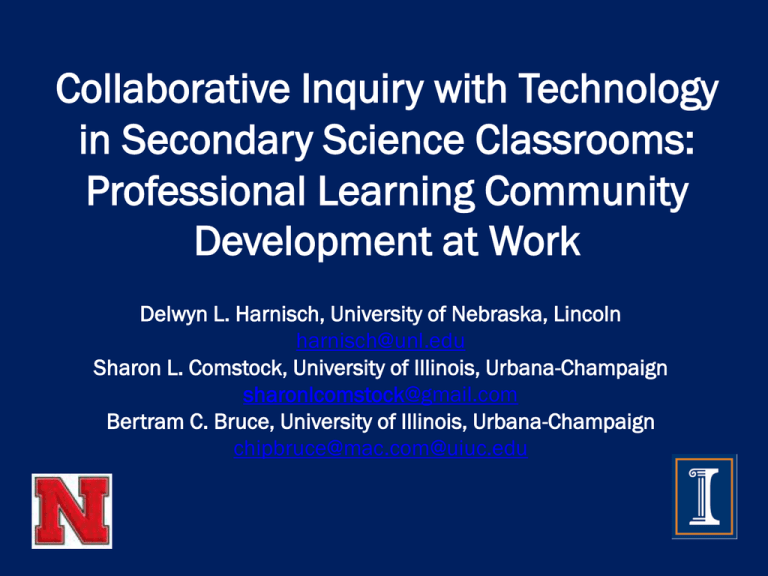
Collaborative Inquiry with Technology in Secondary Science Classrooms: Professional Learning Community Development at Work Delwyn L. Harnisch, University of Nebraska, Lincoln harnisch@unl.edu Sharon L. Comstock, University of Illinois, Urbana-Champaign sharonlcomstock@gmail.com Bertram C. Bruce, University of Illinois, Urbana-Champaign chipbruce@mac.com@uiuc.edu Overview • Gallery of Inquiry • Engagement,Integrative & Collaborative Inquiry • GK-12 Goals, Context, UIUC Model • Research Methods • Culture of Classrooms • Themes of Inquiry • Reflections from Fellows, Teachers and Students • Conclusions Collaborative Inquiry In Classrooms Scholarship of Engagement “Connecting the rich resources of the university to our most pressing social, civic, and ethical problems…Campuses would be viewed by both students and professors not as isolated islands, but as staging grounds for action. At a deeper level…[this means] not just more programs, but a larger purpose, a larger sense of mission, a larger charity of direction in the nation’s life…” (E. Boyer, 1997, p. 92) Integrative Learning • • • Integration of learning across courses, over time, and between campus and community life Development of ability to integrate learning Development of habits of mind to make informed judgments in the conduct of personal, professional, and civic life. (Huber, et al., 2007) Collaborative Inquiry • Learning takes place everywhere, not only in the classroom, but also in many informal settings outside of school. • New modes of learning are not only possible with, but necessary for developing new media (teaching/learning resources). • The key is collaboration across sites for learning; connections among schools, universities, libraries, businesses, etc. (Benson, Harkavy, & Puckett, 2007). • The community is the curriculum (Bruce, 2008). Overview of GK-12 Partnerships • National Science Foundation Graduate Teaching Fellows in K-12 (GK-12) supports teaching fellowships for graduate students in the sciences, technology, mathematics, and engineering (STEM) • This is a collaborative effort between participating K-12 teachers and UIUC. • Graduate students collaborate with STEM Education Faculty, and participating K-12 Teachers to integrate the use of computer-based modeling and scientific visualization in science and mathematics education. Context: NSF GK-12 at UIUC Objectives: • Integration of computer-based modeling, visualization, and informatics in K-12 classrooms • Bioinformatics (Biology Student Workbench), Stella™, Mathematica™, participatory designed visualizations; digital archives, Inquiry Page/iLabs, ChemViz • Position Fellows as scientist/domain experts who leverage institutional relationships and expand access to networks and tools • NCSA, Inquiry/Community Informatics Initiative (CII), Mentors • Professional development for Fellows and Teachers in education and STEM UIUC GK-12 Model • • • • • • • • 2001-2002 to 2008-2009 school years Five to seven middle and high schools per year across the state of Illinois (suburban, rural, urban) Five to seven university Fellows (graduate students) per year University faculty mentors to serve as supports/liaisons for each Fellow Teacher-Fellow partnerships form the core of the program; focus on teaming and collaboration between schools Weekly meetings and support for Fellows Workshops designed around Teachers’ needs Chemistry, physics, biology, social studies, engineering, mathematics, computer science, vocational (HVAC), environmental studies, AP, honors, regular, support, and electives/special courses were utilized Fellow Steven Moore with students in lab (top) Student using Biology Student Workbench in biology Specialized Goals of GK-12 • Offer research-like experiences for K-12 students using computational science, modeling, informatics, and visualizations to do mathematics and science • Augment K-12 science and mathematics curriculum, consistent with national standards, by utilizing computational science, modeling, and visualization tools and methods GK-12 Team Composition • A graduate student/Fellow (Scientist-in-training) • A K-12 teacher (or teacher-team) • A senior faculty university mentor The GK-12 Partnership Responsibilities Fellow Responsibilities: • Active participation in classrooms • Co-teach courses • Act as resident “subject expert” Faculty Responsibilities: • Mentor graduate student in teaching • Mentor participating teacher(s) Study Method: Research Questions • How does the communication between the university researcher and the teacher develop and influence the quality of the instructional environment? • Does the integration of scientific modeling into the innovative instructional methods respond to students’ conceptual and procedural understandings? Methods: Study Design • Research study used a longitudinal approach to assess the effectiveness of GK-12 • This study used a mixed methods approach, including collection and analysis of both quantitative and qualitative data • The key process was to understand the unique environments of each sites and document the contexts in which each team operated Methods • Mixed-methods • • Situated, case study • • UNL (Del Harnisch) and UIUC (Chip Bruce) Formative and Summative • • (Bruce et al. 1993; Stake, 1995) External and internal • • (NSF, 1997, 2002) Incremental effect Instrumentation: • Online Surveys • Fellows(3), Teachers(1), Mentors (1) • Learning Logs • • Site visits • • • Fellows (Informal, weekly-monthly) Informal interviews (Fellows, Teachers, Mentors) Observation: classrooms, GK-12 workshops Evaluation team personnel: – – Lead (Harnisch) and co-lead (Bruce) One-two graduate student evaluators per year • (Buell, Comstock, Davis, Mehra, Rosu) Methods: Data Collection and Analysis • Data Collection: – Field observations – Video – Interviews – Mentor and teacher surveys – Document analysis – Artifact analysis • Data Analysis – Survey data analyze for comparisons between sites – Qualitative data was analyzed for codes and themes to provide an understanding of the context of the sites Capturing Complexity: Each Classroom as a Culture • Triangulation: • Validity enhanced • Holistic, in-depth, inductive = thick data • Longitudinal elements were requested early in IRBs to identify scale of impact and ultimate sustainable outcomes • Next steps: Contacting and interviewing UIUC GK-12 Participant Alumni and school leaders GK-12 teacher alumnus Kathy Gabric, who created curriculum using Biology Student Workbench with Fellow Steven Moore, has since used her GK-12 relationships to work with Rutgers University; and recently earned the Illinois Science Teacher Association Teacher of the Year Award. She has said GK-12 introduced her to bioinformatics: an area in which she has since taught other educators. CREATING A CULTURE OF COLLABORATIVE ASSESSMENT Classroom assessments evolved, using participatory design in instrument development. Created by Evaluation Team Assessment of students’ use of bioinformatics genetics database with Fellow (Moore, S. and Gabric, K. 2002-2003) Created by Teacher Assessment of students’ perceptions of “science” in chemistry classroom “One student put it this way: ‘I think the definition of science is the process of making, testing, and adjusting theories in order to explain how things in the world work.’” (Camasta, S. 2003) Created by Fellow/Teacher team Assessment of students ability to understand the use of neuroscience imaging in a biology classroom (Whalen, C. and Kirkpatrick, M. 2007-8) Biology student taking online survey on use of Biology Student Workbench in the classroom. These data informed the district’s decision to incorporate bioinformatics into the curriculum on a permanent basis and support teacher development and training. Themes Critical scientific literacy in K-12 classrooms (AAAS, 1993) requires authentic inquiry (NRC, 2000) with a basis in the real world. Data over eight years indicate: 1. Collaborative teaming influences the degree of sustainable and transformative change in the classroom. 2. Meaningful inquiry occurs when teachers, scientists, and students feel supported by their institutions. 3. Integrated technologies have long-term impact when they are utilized to authentically solve problems, which creates engagement experiences for both students and teachers. 4. Sustainability and scalability can be achieved at and between institutions where teaming, tools, and inquiry are allowed to develop. Overall Themes • Role and value of embedded formative assessment (and reframing the teacher role toward that of “research practitioner”) • Value of collaborative teaming • The importance of community building and extending communities of practice • The benefits of meaningful technology integration • Facilitation of inquiry- and problem-based learning Tools + Teaming = Transformation Fellow Reflections: The Power of Narrative and STEM – I am most often asked, ‘What does this really mean?’ and I proceed to answer this question by prompting students to use their own knowledge of chemistry in an effort to break apart problems and piece them together. – These students seem to have a deeper and more sophisticated grasp of biology than we did in high school. (I’m partnered with) an excellent teacher, and I wonder if visualization also makes it possible for them to understand. – The students seem to be responding very positively to my presence in the classroom. I receive questions about my research at the University of Illinois almost every time I'm at (the school), and I feel inspired by their inquisitiveness and desire for scientific understanding • Focus for Fellows: Students’ meaning-making, building on students’ content knowledge, humble partnership with teachers, recognizing teachers’ expertise, willingness to be inspired by students’ curiosity, and posing new questions regarding more advanced technologies used in new environments. Modeling using Stella in Chemistry “Some of the most fascinating examples of chemical processes are not addressed in laboratory courses; however, a far greater number of concepts can be examined if students are given the opportunity to apply what they have learned in the classroom to the world around them.” Fellow Michael Kandianis Visualizations Created in Classroom Context: • Fellow Mohan Karulkar’s website – http://mogk12.2ya.com/ • Teacher Susan Camasta’s website – http://www.hinsdale86.org/staff/scamasta/ Student Reflections: The Power of Narrative and STEM – The technology has greatly helped me understand the concepts, especially in science. Because technology helps create a visual image of the material, I learn much quicker with the help of technology. – It is interesting to see someone who is able to explore things that no one really has before. He also helped to show how science relates to real life situations. – The teachers who use technology have a lot more visuals than the teachers who don't. Also, their classes are a lot more interesting because there is more hands on work. – I have become much better and faster at finding things online, and a background knowledge of computers has helped extensively in this class. I have also learned how to create a web site and operate machines such as the DNA fingerprinting machine. • Focus for Students: understanding, engagement, critical thinking, increased confidence, discovery, and real-life problem-solving. Teacher Reflections: The Power of Narrative and STEM – We definitely introduced some new instructional technology into the classroom. While we did that, I think we inspired a grad student towards the education profession. He learned how reach the minds of kids…New experiences, technology, information…could not enter the classroom without (this) partnership…I have been motivated to learn how to use new technology and about new scientific research. – The project was multi-faceted with work on VMD, student-constructed 3-D models, and PowerPoint presentation(s). My students and I have profited greatly from exposure to other software applications, such as VMD. Students know they are using tools that real scientists use. – Expert teachers paired with passionate scientists passing the torch onto the students - doesn't get much better. • Focus for Teachers: Collaborative community built around the problem-solving required by using new tools and technologies. The program became less about the technology itself and more about the critical and engaged inquiries that evolved from their introduction in the context of the scientific discipline. Next Steps: • Longitudinal analysis of the impact of GK-12 with a focus on Fellows: – What has been the experience of the Fellows who have moved on? – Analysis of embedded formative assessment tools used in the process as well as a critique of what “assessment” means at the local classroom level • Reflection following program participation • Reframing the Fellows’ and Teachers’ views of their positions in the classroom from “practitioner” to “action researcher” References • • • • • • • • • AAAS (1993). Benchmarks for science literacy. New York: Oxford University Press. Benson, L., Harkavy, I., & Puckett, J. (2007). Dewey's dream: Universities and Democracies in an age of education reform. Philadelphia: Temple University Press. Boyer, E. L. (1997, 2002). Selected speeches 1979-1995. Princeton: The Carnegie Foundation for the Advancement of Teaching. Bruce, B. C. (2008). From Hull House to Paseo Boricua: The theory and practice of community inquiry. In Bogdan Dicher & Adrian Luduşan (eds.), Philosophy of pragmatism (II): Salient inquiries (pp. 181-198). Cluj-Napoca, Romania: Editura Fundației pentru Studii Europene (European Studies Foundation Publishing House). http://hdl.handle.net/2142/13166 Camasta, S., Karulkar, M., Comstock, S. L. & Harnisch, D. (2006). Collaborative Inquiry and Participatory Design in High School Science: A Case Study in Technology Development and Application. In C. Crawford et al. (Eds.), Proceedings of Society for Information Technology and Teacher Education International Conference 2006 (pp. 3957-3970). Chesapeake, VA: AACE. Comstock, S. (2003). Making the Case for Story: Points on the Qualitative Path. Midwest Qualitative Research Conference, Minneapolis, MN, June 18-21, 2003. EDUCAUSE (2009). Challenges 2009: The EDUCAUSE Top Teaching and Learning Challenges. (http://connect.educause.edu/wiki/TLChallenges09 )(accessed Jan. 20, 2009). Gabric, K., Hovance, C., Comstock, S. & Harnisch, D. (2006). Scientists in their own classroom: The Use of type II technology in the science classroom, Computers in the schools. New York: Haworth. Harnisch, D.L. (2009). Advances in Learning, Teaching and Technology: Professional Learning Community at Work. Refereed Program of the E-Leader Conference at Kuala Lumpur, Malaysia, http://www.g-casa.com, ISSN 1935-4819, Chinese American Scholars Association, New York, New York, USA, January 2009. References • • • • • • • • • Haven, K. (2007). Story proof: The science behind the startling power of story. Westport, CT: Libraries Unlimited. Huber, M. T., Brown, C., Hutchings, P., Gale, R., Miller, R., & Breen, M. (2007, January). Integrative learning: Opportunities to connect. Public Report of the Integrative Learning Project sponsored by the Association of American Colleges and Universities and The Carnegie Foundation for the Advancement of Teaching. http://gallery.carnegiefoundation.org/ilp National Science Foundation (1997, 2002). Mixed methods handbook for evaluations. Frechtling, J. & L. S. Westat, eds. Division of Research and Evaluation, NSF. Washington, D.C. International Society for Technology in Education (2008). National Educational Technology Standards (NETS•T) and Performance Indicators for Teachershttp://www.iste.org/Content/NavigationMenu/NETS/ForTeachers/2008Standards/NETS_T_Standards_Final.pdf (accessed January 20, 2009). Jakobsson, E., & Braatz, R. (2000). GK-12 EdGrid Graduate Teaching Fellowship Program. Proposal to National Science Foundation (NSF) Graduate Teaching Fellows in K-12 Education Program Solicitation (NSF 02-042). Renewal GK-12 Track 2, Raineri, D. and Bievenue, L. (2005). National Commission on Mathematics and Science Teaching. (2000). Before It’s Too Late: A Report to the Nation. Jessup, MD: U.S. Department of Education. National Research Council (1995, 1996). National science education standards. National Academy Press: Washington, D.C. National Research Council (2000). Inquiry and the national science education standards: A guide for teaching and learning. National Academy Press: Washington, D.C. Wallace, J.W. & Louden, W. (2000). Teachers’ learning: Stories of science education. Dordrecht: Kluwer (Springer). Acknowledgements GK-12 Program participants at the University of Illinois, Urbana-Champaign are grateful for the support of the National Science Foundation. The program was administered under Principal Investigator Dr. Deanna Raineri and Project Coordinator Lisa Bievenue; past leadership includes Drs. Eric Jakobsson and Richard Braatz. Gratitude is expressed to present and past GK-12 teachers, Fellows, mentors, evaluators, students, and administrators.
